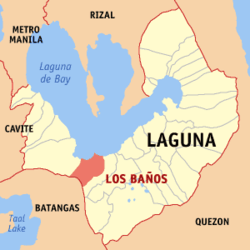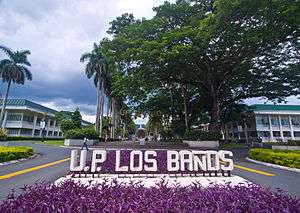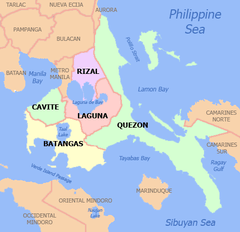Los Baños, Laguna
| Los Baños | ||
|---|---|---|
|
Municipality (Special Science and Nature City) | ||
|
Los Baños Municipal Hall | ||
| ||
| Nickname(s): Spcial Science and Nature City[1] | ||
 Map of Laguna showing the location of Los Baños | ||
.svg.png) Los Baños Location within the Philippines | ||
| Coordinates: 14°10′N 121°13′E / 14.167°N 121.217°ECoordinates: 14°10′N 121°13′E / 14.167°N 121.217°E | ||
| Country | Philippines | |
| Region | Calabarzon (Region IV-A) | |
| Province | Laguna | |
| District | 2nd District of Laguna | |
| Founded | 15 September 1615 | |
| Special Science and Nature City of the Philippines | August 7, 2000 | |
| Barangays | 14 | |
| Government[2] | ||
| • Mayor | Caesar P. Perez | |
| • Vice Mayor | Copie A. Alipon | |
| Area[3] | ||
| • Total | 54.22 km2 (20.93 sq mi) | |
| Population (2015 census[4]) | ||
| • Total | 112,008 | |
| • Density | 2,100/km2 (5,400/sq mi) | |
| Demonym(s) | Los Bañense | |
| Time zone | PST (UTC+8) | |
| ZIP code | 4030, 4031 | |
| Dialing code | +63 (0)49 | |
| Income class | 1st | |
| Website |
www | |
Los Baños is a first class urban municipality in the province of Laguna, Philippines. According to the 2010 census, it has a population of 101,884 inhabitants.[5] It has a total land area of 56.5 square kilometers and is bordered on the south and south-west by Mount Makiling, on the north by Laguna de Bay, on the north-west by Calamba City and on the east by the town of Bay. The town is located 63 kilometres (39 mi) southeast of Manila and is accessible via the South Luzon Expressway.
The municipality lies on the northern slopes of the long dormant volcano Mount Makiling and is known among tourists for its hot spring resorts. Los Baños also hosts the University of the Philippines, along with other foreign and local and international research centers, such as the International Rice Research Institute, the ASEAN Center for Biodiversity, the Philippine Rice Research Institute, Philippine Carabao Center at UPLB, and SEAMEO-SEARCA, making the town a temporary home for tens of thousands of both local and foreign undergraduate and graduate students, researchers and support staff.
Aside from its importance in academics, science and research, Los Baños is a well-known tourist destination. Because of the town's proximity to Metro Manila, Los Baños' hot spring resorts are frequent weekend or summer getaways for residents of the vast metropolis and tourists from other places in the Philippines and abroad. Tourists who visit Los Baños also come to the several native delicacies stores in the town to buy the town's famous Buko pie (coconut meat pie) as well as a home-grown brand of chocolate cake.[6]
History
Precolonial and Spanish colonial period
Los Baños started as a settlement, a barrio of Bay, called Mainit, the Tagalog term for "hot", alluding to the thermal springs at the foot of Mount Makiling. By 1589, through a Franciscan friar, it became popularly called by its present name, "Los Baños," which is Spanish for "bathing place."[7]
In 1595, a temporary building made of bamboo and cogon was built to serve as shelter for the patients who journeyed to Mainit to seek cures for their ailments. It was on 15 September 1615 when the friars administered Los Baños as a separate town from Bay.[7]
In 1671, more permanent structures like churches and hospitals were built only to be destroyed by a fire in 1727. The structures were re-erected at a slow rate. The church which now stands in the municipal center of Los Baños dates back to 1851. The Spanish Governor's palace was built in 1879 but was only completed in 1892.
American colonial period
In 1909, the University of the Philippines College of Agriculture (UPCA) was established.
The UPCA became a Japanese camp for prisoners of war, an internment camp for allied nationals, a target of Kempetai punitive measures, and the headquarters of a secret organization of guerrillas. On 23 February 1945, US forces of the First Battalion, 511th Parachute Infantry Regiment of the Eleventh Airborne Division led a combined amphibious and airborne raid against the Japanese prison of war camp, rescuing over 2,000 allied nationals. They killed the 250-man Japanese garrison. In order to haste the evacuation of civilians from their belongings, US forces and Filipino guerrillas were forced to burn the barracks before Japanese reinforcements would arrive to the area. Only Baker Hall, the armory-gymnasium, remained.[8]
In 1959, the 10th World Scout Jamboree was held in Los Baños, with the theme "Building Tomorrow Today" with an attendance of 12,203 scouts.
In 1962, the International Rice Research Institute (IRRI) began its operation.
Modern era
In 1979, the evolution and development of academic excellence in Los Baños moved the people of Los Baños to request then president Ferdinand Marcos to declare the municipality as "A Special University Zone", granted on 15 June 1982 by virtue of letter of instruction No. 883.
Los Baños was further declared as an "Agriculture, Forestry, and Life Sciences Community" on 17 March 1982 by virtue of Executive Order No. 784 (Section 23).
On August 7, 2000, Los Baños was declared a “Special Science and Nature City of the Philippines” by virtue of Presidential Proclamation 349. It was signed by then President Joseph Estrada. The Proclamation is in recognition of the town’s important contribution in country. The municipality has remained as the country’s hub of science and nature with the presence of national and international research institutions collaborating towards the advancement of science research.[9]
The 6th Flora Malesiana, a triennial gathering of people with botanical expertise regarding "Malesia," was held from 20 to 24 September 2004. It provided a forum for Flora Malesiana members and encouraged publications on Malesian plants.
During the 2005 Southeast Asian Games, Los Baños played host to the aquatics events, with the newly built Trace Aquatic Center at Trace College serving as the venue.
The headquarters of the Association of Southeast Asian Nations (ASEAN) Center for Biodiversity was opened on 8 August 2006 at the DENR-Ecosystems Research and Development Bureau, located at the College of Forestry, University of the Philippines Los Baños. It coincided with the foundation day celebrations of the organization. The Philippines assumed the Chairmanship of ASEAN in 2006 and played host to the 12th ASEAN and East Asia Summits (held in Metro Cebu, January 2007).
In January 2007, the 5th ASEAN Inter-Club Age-Group Swimming Championships was held in the Trace Aqua Sports Center.
Los Baños also plays host to the UAAP, as the Trace Aquatics Center has served as the venue for the league's swimming competitions since UAAP Season 70.
Currently, Los Banos has the largest scientist community in South East Asia. Although it is a small town, it has contributed widely through scientific achievements and contributions locally and worldwide particularly on agriculture.
Geography
Los Baños is nestled between two of Southern Luzon's most dominant geographical features - Mount Makiling to the south and south-west and Laguna de Bay to the north.[10] In fact, Laguna de Bay's southernmost tip is at Barangay Bambang, and Barangay Bagong Silang is already halfway up Mount Makiling. Both the mountain and the lake are volcanic features - Makiling being a potentially active volcano whose geothermal activities gave birth to the hot springs after which the town was named, and Laguna de Bay being the filled-in caldera of a massive prehistoric volcano.
Another notable geological feature is Tadlac Lake, a maar lake whose almost perfectly round shape and uncharted waters have led some locals to call it "the enchanted lake." Others call it "alligator lake", a reminder that it served as the last bastion of Laguna de Bay's once-plentiful cayman population, which has since been wiped out and is now just another legendary part of Philippine history.
Rivers
The town of Los Baños is crossed by five rivers or creeks:[10]
- The Dampalit river, which is named after an edible herb, dampalit (Sesuvium portulacastrum), which often grows near river shores, originates on the north face of Mt. Makiling east of the Philippine High School for the Arts, and feeds into Laguna lake at the boundary of Barangays Lalakay and Bambang.[10]
- The Saran creek, whose headwaters begin somewhere near the municipal dumpsite, flows through Barangay Anos near the municipal cemetery, and feeds into the lake at Barangay Malinta.
- The Pele creek, named after the pili tree (Canarium ovatum), flows through the west side of Barangay Batong Malake and has its mouth at the boundary of Barangays Malinta and Mayondon.[10]
- The Molawin River, most familiar to UPLB students because it flows through the UPLB campus and the Makiling Botanic Gardens, is named after the Molave tree (Vitex parviflora).
- The Maitim river, whose name means "black", flows through the westernmost portions of Los Baños, marking the town's boundary with its neighboring town of Bay. The Molawin and Maitim rivers merge just a few meters before feeding into Laguna de Bay at the shore of Barangay Maahas.[10]
Climate
Los Baños has a tropical monsoon climate (Köppen climate classification Am).
| Climate data for Los Baños, Laguna | |||||||||||||
|---|---|---|---|---|---|---|---|---|---|---|---|---|---|
| Month | Jan | Feb | Mar | Apr | May | Jun | Jul | Aug | Sep | Oct | Nov | Dec | Year |
| Average high °C (°F) | 29.1 (84.4) |
30.2 (86.4) |
31.9 (89.4) |
33.5 (92.3) |
33.6 (92.5) |
32.5 (90.5) |
31.5 (88.7) |
31.2 (88.2) |
31.1 (88) |
31.0 (87.8) |
30.2 (86.4) |
29.2 (84.6) |
31.3 (88.3) |
| Daily mean °C (°F) | 25.3 (77.5) |
25.9 (78.6) |
27.1 (80.8) |
28.5 (83.3) |
28.8 (83.8) |
28.2 (82.8) |
27.5 (81.5) |
27.4 (81.3) |
27.2 (81) |
27.1 (80.8) |
26.6 (79.9) |
25.7 (78.3) |
27.1 (80.8) |
| Average low °C (°F) | 21.5 (70.7) |
21.6 (70.9) |
22.3 (72.1) |
23.5 (74.3) |
24.1 (75.4) |
24.0 (75.2) |
23.6 (74.5) |
23.6 (74.5) |
23.4 (74.1) |
23.3 (73.9) |
23.0 (73.4) |
22.3 (72.1) |
23.0 (73.4) |
| Average rainfall mm (inches) | 55 (2.17) |
27 (1.06) |
30 (1.18) |
38 (1.5) |
159 (6.26) |
208 (8.19) |
280 (11.02) |
258 (10.16) |
246 (9.69) |
252 (9.92) |
226 (8.9) |
163 (6.42) |
1,942 (76.46) |
| Source: [11] | |||||||||||||
Demographics
| Population census of Los Baños | ||
|---|---|---|
| Year | Pop. | ±% p.a. |
| 1990 | 66,211 | — |
| 1995 | 71,683 | +1.50% |
| 2000 | 82,027 | +2.93% |
| 2007 | 98,631 | +2.58% |
| 2010 | 101,884 | +1.19% |
| 2015 | 112,008 | +1.82% |
Barangays
Los Baños is politically subdivided into 14 barangays.
| Barangay | Captain | Population (2010)[5] |
|---|---|---|
| Anos | Celerino L. Balasoto | 7,446 |
| Bagong Silang | Rufino A. Maloles | 577 |
| Bambang | Joselito C. Manzanares | 7,021 |
| Batong Malake | Janos S. Lapis | 11,884 |
| Baybayin (poblacion) | Anselmo M. Lapitan | 1,307 |
| Bayog | Cesar L. Moldez | 9,671 |
| Lalakay | Gaudencio P. Macatangay | 4,253 |
| Maahas | Ferdinand P. Vargas | 6,800 |
| Malinta | Rolando L. Erroba | 6,258 |
| Mayondon | Victorio A. Reyes | 16,181 |
| Tuntungin-Putho | Ronaldo N. Oñate | 8,692 |
| San Antonio | Cecilio Magsino | 13,173 |
| Tadlac | Juan Marvin S. Bautista | 3,342 |
| Timugan (poblacion) | Florencio D. Bautista | 5,279 |
Places of interest

- University of the Philippines Los Baños and other places of interest within its administered area
- Mount Makiling
- Makiling Botanic Gardens
- ASEAN Center for Biodiversity
- UPLB Museum of Natural History
- Flatrocks - creek usually frequented by hikers
- Mudspring - Presumed volcanic crater of Mt. Makiling
- Peak 2 - Highest peak of Mt. Makiling
- Pook ni Maria Makiling, an eco-tourism site adjacent to the Jamboree Site, National Arts Center, and U.P. Los Baños
- Boy Scouts of the Philippines and Jamboree Site - a campsite at the foot of Mount Makiling adjacent to U.P. Los Baños, which is being managed by the Boy Scouts of the Philippines and the site of the 10th World Scout Jamboree in 1959, the 1st and 12th Asia Pacific Jamboree in 1973 and 1991, and the 1st ASEAN Jamboree in 1993.
- National Arts Center - a patch of land at the foot of Mount Makiling adjacent to U.P. Los Baños, which is being managed by the Cultural Center of the Philippines and the site of the Philippine High School for the Arts, a special school for young artist scholars.
- University of the Philippines Open University
- International Rice Research Institute
- Dairy Training & Research Institute
- Philippine Carabao Center at UPLB (PCC at UPLB) - conducts R&D in water buffalo; implements other programs related to water buffalo development; one of the 13 regional centers of PCC (see the link below)
- Agricultural and Life Sciences Complex
- National Institute of Molecular Biology and Biotechnology (NIMBB/BIOTECH) - UPLB
- Institute of Plant Breeding
- APEC Center for Technology Exchange and Training for Small and Medium Enterprises (ACTETSME)
- National Crop Protection Center (NCPC)
- College of Agriculture AgriPark
- Baker Hall (also known as Los Baños Internment Camp during World War II)
- Mount Makiling
- Philippine Council for Agriculture, Aquatic, and Natural Resources Research and Development (PCAARRD)
- Department of Science and Technology Regional Office for Region IV (DOST IV)
- Magnetic Hill
- Dampalit Falls
- Immaculate Conception Parish - a centuries-old church at the town proper (Poblacion/Bayan)
- Paciano Rizal Shrine - house of Paciano Rizal, brother of National Hero Jose Rizal
- Paciano Rizal Park - park dedicated to Paciano Rizal, brother of National Hero Jose Rizal
- Trace Aqua Sports Complex and Museum - aquatic sports venue for the 2005 SEA Games and Philippine Olympic Festival
- Los Baños Eco-Waste Processing Area - noted and commended for its solid waste management
- Yamashita Shrine - execution site of Gen. Homma and Gen. Yamashita
See also
- Raid at Los Baños, Military history of the Philippines during World War II
References
- ↑ "The Special Science and Nature City | Municipality of Los Banos". Losbanos.gov.ph. 2015-04-23. Retrieved 2016-11-17.
- ↑ "2013 Election Results". Quezon City, Philippines: Commission on Elections. Retrieved 19 July 2013.
- ↑ "Province: LAGUNA". PSGC Interactive. Makati City, Philippines: National Statistical Coordination Board. Retrieved 27 February 2013.
- ↑ "Highlights of the Philippine Population 2015 Census of Population | Philippine Statistics Authority". Psa.gov.ph. 2016-05-19. Retrieved 2016-11-17.
- 1 2 "Total Population by Province, City, Municipality and Barangay: as of May 1, 2010" (PDF). 2010 Census of Population and Housing. National Statistics Office. Retrieved 13 February 2013.
- ↑ "Meet the couple behind Laguna's 'famous cakes'". ABS-CBN Broadcasting Corporation. Retrieved 3 November 2016.
- 1 2
- ↑ Bruce Henderson, Rescue at Los Baños: The Most Darking Prison Camp Raid of World War II (2015)
- ↑ "The Special Science and Nature City". Municipality of Los Baños. Retrieved 17 August 2016.
- 1 2 3 4 5 Plan of Road Network for Municipality of Los Baños, Province of Laguna, Island of Luzon (Map). Los Baños Municipal Planning and Development Office.
- ↑ "Climate data for: Los Baños". En.climate-data.org. Retrieved 2013-05-12.
External links
| Wikimedia Commons has media related to Los Baños, Laguna. |
| Wikivoyage has a travel guide for Los Baños (Laguna). |
- Municipality of Los Baños official
- Los Baños History
- Philippine Standard Geographic Code
- Philippine Census Information
- Local Governance Performance Management System
 |
Laguna de Bay |  | ||
| Calamba City | |
Bay | ||
| ||||
| | ||||
| Santo Tomas, Batangas | Bay |

